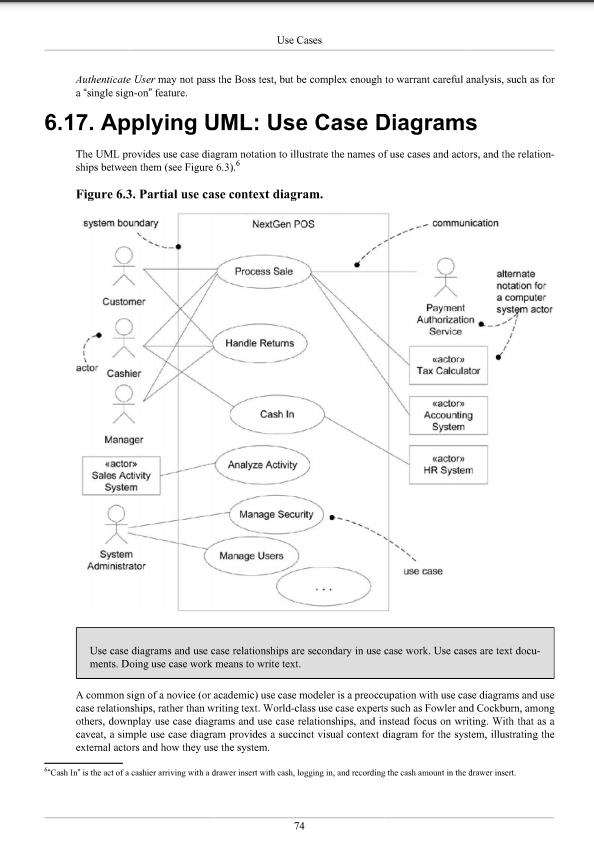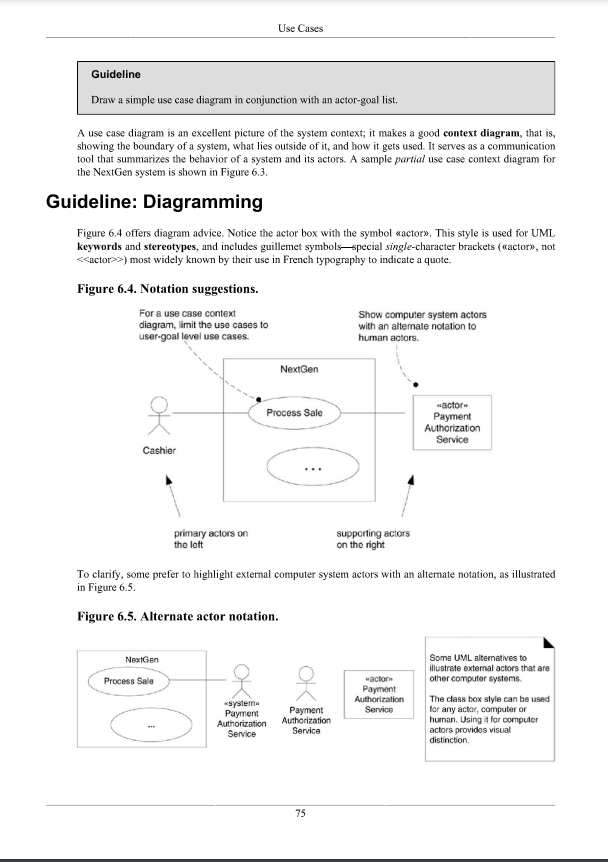Answered step by step
Verified Expert Solution
Question
1 Approved Answer
Use CaseModeling Part 1: Context Diagram Develop a usecase context diagram for the NexGen POS system based on the format of Larmanfigure 6.3 and referencing
Use CaseModeling Part 1: Context Diagram Develop a usecase context diagram for the NexGen POS system based on the format of Larmanfigure 6.3 and referencing figures 6.4 and 6.5. Use Larman chapter 6, especially 6.16 and 6.17, as guides. Submit one document in either MS Word or PowerPoint format.


Rubric:
A detailed context diagram is presented which builds on the example in the text.
Very high quality deliverable. Well labeled, clear, and professional.
Use Cases Authenticate User may not pass the Boss test, but be complex enough to warrant careful analysis, such as for a single sign-on" feature 6.17. Applying UML: Use Case Diagrams The UML provides use case diagram notation to illustrate the names of use cases and actors, and the relation- ships between them (see Figure 6.3). Figure 6.3. Partial use case context diagram. system boundary NextGen POS communication Process Sale alternate notation for a computer system actor Customer Payment Authorization Service Handle Returns actor cactor Tax Calculator Cashier Cash In cactor Accounting System Manager Analyze Activity cactor HR System actor Sales Activity System Manage Security System Administrator Manage Users use case Use case diagrams and use case relationships are secondary in use case work. Use cases are text docu- ments. Doing use case work means to write text. A common sign of a novice (or academic) use case modeler is a preoccupation with use case diagrams and use case relationships, rather than writing text. World-class use case experts such as Fowler and Cockburn, among others, downplay use case diagrams and use case relationships, and instead focus on writing. With that as a caveat, a simple use case diagram provides a succinct visual context diagram for the system, illustrating the external actors and how they use the system. *Cash In' is the act of a cashier arriving with a drawer insert with cash, logging in, and recording the cash amount in the drawer insert. 74 Use Cases Guideline Draw a simple use case diagram in conjunction with an actor-goal list. A use case diagram is an excellent picture of the system context; it makes a good context diagram, that is, showing the boundary of a system, what lies outside of it, and how it gets used. It serves as a communication tool that summarizes the behavior of a system and its actors. A sample partial use case context diagram for the NextGen system is shown in Figure 6.3. Guideline: Diagramming Figure 6.4 offers diagram advice. Notice the actor box with the symbol actor. This style is used for UML keywords and stereotypes, and includes guillemet symbolsspecial single-character brackets (cactory, notStep by Step Solution
There are 3 Steps involved in it
Step: 1

Get Instant Access to Expert-Tailored Solutions
See step-by-step solutions with expert insights and AI powered tools for academic success
Step: 2

Step: 3

Ace Your Homework with AI
Get the answers you need in no time with our AI-driven, step-by-step assistance
Get Started


